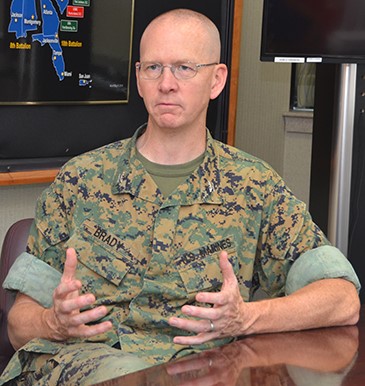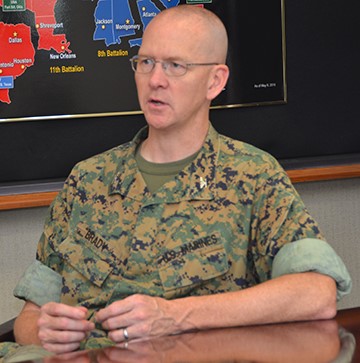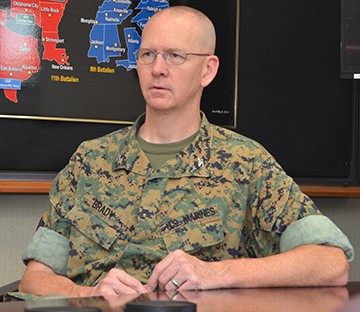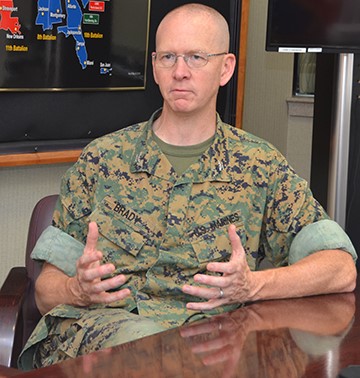Transformation moves forward under newly-formed team
By Skip Wiseman
USMEPCOM Public Affairs
Photos by Amy Gregorski
USMEPCOM Public Affairs
Upgrading from the legacy United States Military Entrance Processing Command Integrated Resource System, known as USMIRS, to USMIRS 1.1 and implementing the Military Health System GENESIS, known as MHS GENESIS, are the two major components for the command reaching its DoD-mandated goal of paperless processing by 2025.
Although work on MHS GENESIS and the Joint Legacy Viewer, called JLV, will continue, Marine Corps Col. Richard T. Brady, USMEPCOM commander, has made completing USMIRS 1.1 the top priority in the command’s transformation efforts.
“It all gets back to the overall modernization efforts and how we support our recruiting partners and how we resource this command,” he said.
“There are always going to be budgetary pressures on the command,” Brady said. “We see continued pressure on us to modernize to reduce costs. We are going to have to continue to sequence our major programs like USMIRS 1.1, MHS GENESIS and JLV to get where we want to be five years out – paperless systems in which we’re a much more agile, lean organization that’s not just responding to problems, but predicting when problems are going to come up and supporting our recruiting partners, regardless of where their mission is.

“Sequencing is very important and very challenging,” he said. “It’s probably the most challenging thing to do with all these acquisition programs. Nothing operates in a vacuum. Everything is interlinked.”
Brady stressed the need for balancing day-to-day operations with modernization. He used the Washington Metropolitan Area Transit Authority, commonly called Metro, as an example saying the system focused almost entirely on modernization for 20 years while neglecting basic track maintenance. As a result, the system experienced a series of accidents and it took more than three years to correct all the maintenance issues.
He has also established a narrower focus for the command’s transformation efforts and set up the Rapid Delivery Team, or RDT, to spearhead the program.
“I’ve been very clear that our main focus, at least for next 12-18 months, is going to be USMIRS 1.1,” Brady said. “That’s not to say other transformation efforts aren’t important. A lot of the medical transformation is incredibly important, but we can’t do everything at once.
“We’re going to prioritize USMIRS 1.1, get that out the gate, get it operational,” he said. “The plan then is to get medical modernization right behind it. In the meantime, we are going to continue pilot projects for medical modernization so we better understand it.
“MHS GENESIS, JLV and the prescription drug pilots are going to continue going forward,” Brady said. “When we are ready to implement, we’ll be able to do it very quickly.
The RDT includes people from several directorates who have been assigned to the team full time so they can dedicate all their efforts to transformation. This is particularly important because the civilian contractor designing USMIRS 1.1, Tandem, is using agile development methods.

Agile development involves two-week “sprints,” developing software with regular input from people who will use the system. Milwaukee MEPS and Chicago MEPS are talking often with the contractors. Denver MEPS will enter the partnership soon.
“The contractors are sitting with the users, asking what they like about a screen,” Brady said. ‘“Is the best place for the applicant’s picture on the upper right or bottom left? What do you want next to the applicant’s picture? Do you want basic biographical data – name, date of birth, Social Security number – or would you rather have that someplace else?’
“Constant customer interface is very important,” he said. “When you buy something off a web site, you don’t need anybody sitting down with you for a week teaching you how to use the system. It’s very intuitive. USMIRS 1.1 is intended to be an intuitive system that anybody can sit down and use.
“When the contractor initially came in and was working with the MEPS staff, the staff asked, ‘Why do you keep coming back to us? We already told you what it looks like. Just go and build the system and bring it back to us complete.’”

The RDT will play a key role in developing USMIRS 1.1, and establishing best practices for MHS GENESIS and the JLV. It has had some early success in obtaining the authority to operate USMIRS 1.1 on the network, Brady said.
“They’ve made some really good headway on the contracting side,” he said, “getting the contracts they’re going to need for the continued development and deployment of the system.
“It’s important to note that we’re still at a very risky stage in the development of USMIRS 1.1,” Brady said.
He explained that transformation projects follow an “S” curve and that there is little visible progress at the beginning of the process.
“You have to get through that before you start ramping up and making some very quick gains,” Brady said. “We’re still way down at the bottom of the S curve where it’s hard to see the gains we’re making, but we still have to put in the resources to support it and not overestimate the gains and not say we’re doing more than we really are.
“Let’s be intellectually honest and give an honest assessment of where this program is and support it to get it up there on a ramp where we can get it into deployment,” he said “That’s the challenge with any transformation project, not just USMIRS 1.1.”
The RDT is also important because while the agile philosophy has long been used in the private sector, it is a new concept for the military and most government agencies.
“We in the military are used to knowing what the objective is,” Brady said. “Think about it as a combat situation. There’s the objective; you need to take that hill. Once you’ve taken the hill, you’ve achieved your objective.
“That’s not how agile works,” he said. “It’s more of a process, knowing there’s an environment out there you want to operate in, but not knowing what that environment looks like. You just know you need to be driving toward it and when you get there, that objective will emerge out of the process.”
Agile methodology requires regular communication between the people developing the system and the people who will use it.
“It’s continuous engagement with the customer, asking very good, probing questions, challenging our business processes,” Brady said. “We needed that because our business processes have been developed over 25 years.
“Some may have been very good at the time and may still be relevant but we need to ask if we still need to do some of them,” Brady said. “It might have been relevant in 2002, but that doesn’t mean it is today. It’s important to go through the process and have customer engagement.

USMIRS 1.1 is the only transformation initiative that is entirely under USMEPCOM’s control, Brady said.
“It is entirely in our hands,” he said. “MHS GENESIS is a joint program. It’s run by the by the Defense Health Agency, supporting the Department of Defense, Homeland Security and the Department of Veterans Affairs. We have a lot less control over that program and its timing.”
Brady will focus on four areas of USMIRS 1.1 – performance, users, business processes and the ecosystem.
“When I go up to the Milwaukee MEPS, what I’m really watching is how the MEPS employees use the system and their response to it,” he said. “Do they find it more cumbersome than USMIRS 1.0 or are they embracing it?
“What I’ve seen so far is very positive,” Brady said. “After a few days of working on USMIRS 1.1 the employees are very excited about it. USMIRS 1.1 has to perform better than USMIRS 1.0 in the end. The users have to adopt it.
“Finally, it has to tie into the system of systems, all the systems USMIRS talks to,” he said. It all has to be mutually supporting for this system to be successful.”
Organizational change must be part of modernization efforts, Brady said.
“If everything stays the same and you bring in a new system, you’re not going to get the same payoff out of the system that you could with organizational changes as well,” he said. “We’re going to be looking at some modest organizational changes to support transformation.
“The most evident one you see so far is the Rapid Delivery Team for USMIRS 1.1,” Brady said. “It is a unique organization that has been established to support the continued development and deployment of USMIRS 1.1. They’ve been given very broad authorities.
“They’ve been given a mandate to have USMIRS 1.1 rolled out by September 2020,” he said. “Hopefully we’ll not only get successful development of USMIRS 1.1, but a model of what we can do in the future to roll out other modernization programs. The RDT will be a model for and MHS GENESIS team, a JLV team or any other transformation or modernization project.”